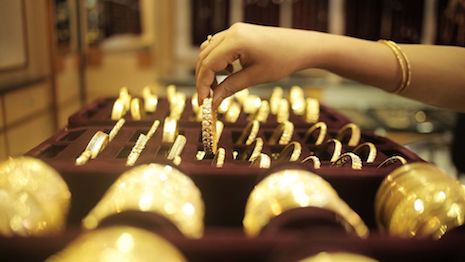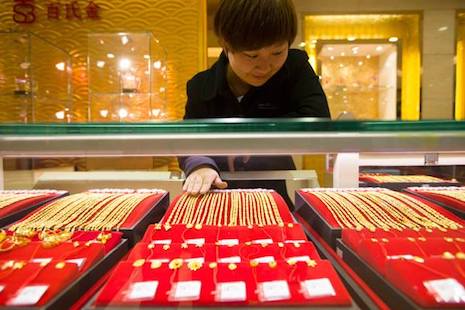 Gen Z consumers have a weaker emotional attachment to gold. Image credit: World Gold Council
Gen Z consumers have a weaker emotional attachment to gold. Image credit: World Gold Council
Consumers across all generations look to gold as a stable investment asset, but new research indicates that Gen Zers are less likely than their older counterparts to have an emotional attachment to the precious metal.
A report from the World Gold Council finds that while millennials’ gold purchase plans for the next year closely mirror earlier generations, Gen Z consumers’ purchase intent drops off. Despite the generational divide in attitude, a third of consumers between the ages of 18 and 38 have bought into gold as an asset, and half of them say they would purchase gold again.
"The research suggests that consumer sentiment surrounding gold is generally positive," said Louise Street, market intelligence manager at the World Gold Council, London.
"Over half of the people we surveyed have bought gold at one time or another," she said. "They feel strongly that it offers protection and security: two-thirds of retail investors and almost three quarters of fashion and lifestyle consumers believe that it will never lose its value over the long term.
"People buy gold as an investment to protect their wealth. But people don’t value gold purely for financial reasons – they have a strong emotional connection to it, feeling that it is a good heirloom and can bring good luck. And they are likely to buy or gift it on occasions that are laden with emotions – weddings, anniversaries, Valentine’s Day and birthdays."
The report is based on a survey of 18,000 consumers from marketings including China, India, North America, Germany and Russia.
Security sentiment
Consumers equate gold with security, and about two-thirds say they use gold to guard against currency fluctuations. Another 65 percent believe that gold will not lose its value.
Forty-four percent of consumers say they have bought gold to diversify their assets or lower risk, while 31 percent chose to invest because a friend or advisor told them to.
On average, six in 10 consumers trust gold more than their local currency, and this tendency is even more pronounced in emerging markets such as India and China. Consumers from China and India are also more likely to have purchased some form of gold investment, with around seven in 10 residents saying they have invested in the metal.
Luxury buyers from China and India are more apt to purchase fine gold jewelry than their counterparts in the U.S., with respective purchase rates of 66 and 58 percent compared to Americans’ 43 percent.
In luxury, gold pieces are the fourth most purchased product category, coming in behind cosmetics, silver jewelry and designer clothing, and ahead of accessories and footwear. Similarly to the idea of gold as an investment, 81 percent of luxury customers say that gold jewelry is precious enough to be passed down as an heirloom.
As expected, as consumers’ income levels rise, they become more likely to have purchased gold.
Globally, 51 percent of consumers believe that owning gold will bring them good luck. This belief peaks with consumers between the ages of 18 and 44.
While gold has long held significance in China, only four in 10 Chinese Gen Zers say they believe gold can lead to good luck, compared to nine in 10 Chinese individuals between the ages of 55 and 65.
 Young consumers in China do not have the same emotional connection to gold as older generations. Image credit: World Gold Council
Part of the disconnect with Gen Zers could be due to their differentiated take on fashion purchases, which tends to favor function and ethics over flash. While 46 percent of Gen Z consumers globally say that gold helps them fit in with their friends, only 31 percent of Chinese Gen Zers agree.
Indicative of this cultural divide, only 18 percent of Chinese Gen Z shoppers bought gold jewelry within the last year, compared to 26 percent of this generation on an international level.
Young consumers in China do not have the same emotional connection to gold as older generations. Image credit: World Gold Council
Part of the disconnect with Gen Zers could be due to their differentiated take on fashion purchases, which tends to favor function and ethics over flash. While 46 percent of Gen Z consumers globally say that gold helps them fit in with their friends, only 31 percent of Chinese Gen Zers agree.
Indicative of this cultural divide, only 18 percent of Chinese Gen Z shoppers bought gold jewelry within the last year, compared to 26 percent of this generation on an international level.
"Gen Z consumers in China are less likely to follow the traditions of the older generations in buying gold jewelry," Ms. Street said. "They like to express their individuality and are more likely to want to spend their incomes on experiences than older generations."
Across all consumers, gold jewelry purchases are often used to mark occasions. Anniversaries are the number one reason for buying, followed by birthdays. Education and trust The World Gold Council sees an opportunity for gold among the 38 percent of consumers who have never purchased gold before but who are open to future investments. This group’s top barrier to purchasing is trust, whether they are investing in bars or buying jewelry. There are also educational and awareness hurdles. For instance, 28 percent of this audience says that they can buy less expensive jewelry that looks the same. As consumers become more concerned with the ethics surrounding precious metal mining, jeweler Tiffany & Co. is partnering with NGO Resolve to incorporate its sustainably sourced Salmon Gold into its designs. Resolve’s initiative simultaneously mines and restores fish habitats that were impacted by earlier gold digging operations. As the first batch of Salmon Gold is being released, both Tiffany and technology giant Apple are using the precious metal in their supply chain (see story). Aside from challenges due to changing perceptions among younger shoppers, gold is facing other positioning issues. Jewelers are pushing for changes in Federal Trade Commission guidelines, which they are concerned could cause gold to lose its position as a precious and luxurious metal, according to a panel at the Initiatives in Art and Culture Gold Conference. Whereas gold previously needed to be at least 10 karats, the FTC has relaxed its rules, allowing for any karat amount to be labeled as gold, as long as the karat amount is specified. This has implications for the jewelry industry, as brands look to promote and sell fine jewelry, potentially leading to waning consumer confidence in the metal due to lesser quality creations hitting the market (see story)."Two of the major barriers we identified are around trust and awareness," Ms. Street said. "Within trust, the messages that need to be clearly communicated are around the quality and authenticity of the gold that a retailer is selling, and to validate the credibility of the retailer. Consumers need to trust in the product they are buying and the business they are buying it from.
"And messages that address knowledge gaps are also needed," she said. "Investors need to know more about the range of gold products available – particularly those that are more affordable – and about the buying process for gold investments. Communications that clearly explain how to buy gold, outlining a simple process, would help.
"For jewelry consumers, they need to see gold in a range of different styles to overcome perceptions that it is ‘too flashy’ or does not suit their style."
